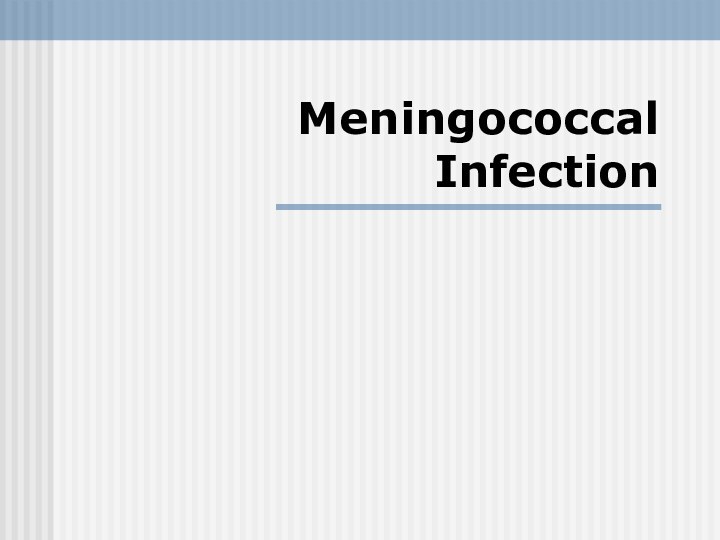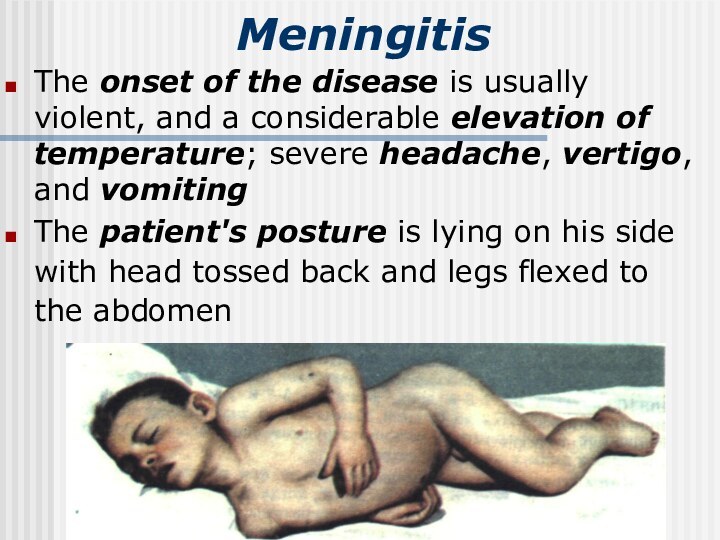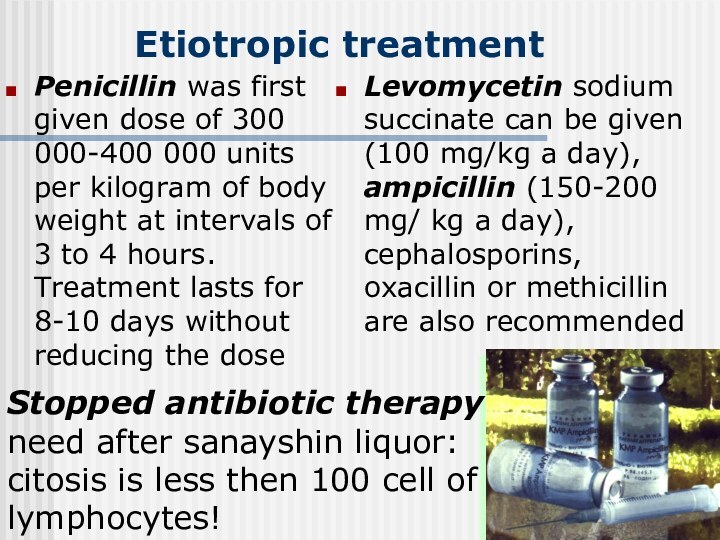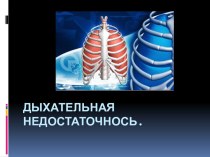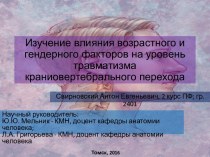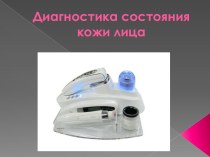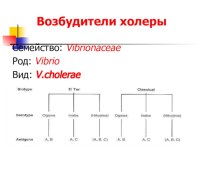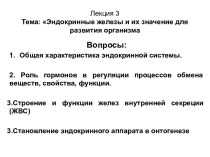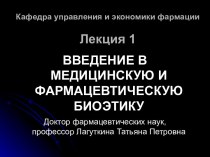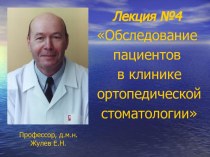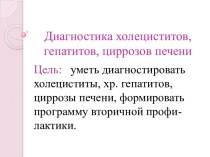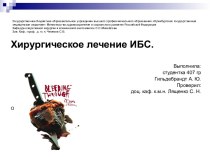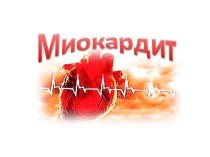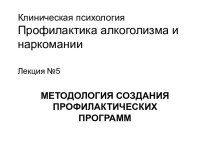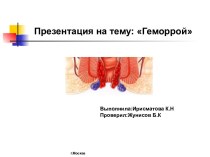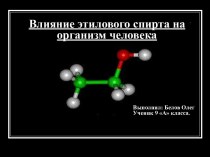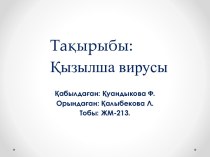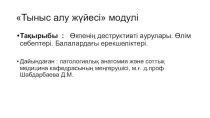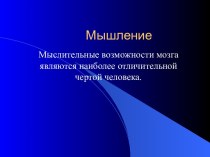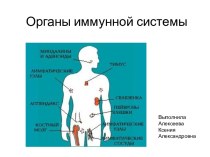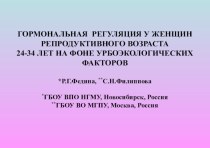Слайд 2
Etiology
the causative agent
is meningococcus
(Neisseria meningitidis).
this
microorganism
has the form of a diplococcus, which stains
well with aniline dyes, and is gram-negative
grows on media containing human protein (blood serum)
very unstable and perishes rapidly outside the organism
several serotypes of meningococ (A, B, C, D, Z, X, and Y) have been discovered
Слайд 3
Epidemiology
the sources of infection are patient and
carriers
meningococcus expel the causative agent with the secretions
from the nasopharynx and upper respiratory passages
Infection is transmitted by the aerial-droplet route
The susceptibility of man to meningococcal infection is slight: the susceptibility index does not exceed 0.5 %
The meningococcal infection is characterized by periodic rises of the incidence every 10-15 year or longer
Слайд 4
Pathogenesis and Pathology
The portal of the infection
entry is the nasopharyngeal mucous
The carrier state develops
frequently, while nasopharyngitis and generalized form (in 0.5-1 % of cases) occurs significantly less frequently
The important role in mingococcemia belongs to marked intoxication with the endotoxin released during decomposition of the microbial bodies - microcirculation is thus affected to provoke thrombosis and extravasates
Necrosis in the adrenal glands with diffuse hemorrhages and decomposition of the glandular tissue - fulminating forms (Waterhause-Friderichsen syndrome )
Слайд 5
Purulent meningitis develops due to the ingress of
the meningococcus into the soft meninges of the brain
and the spinal cord
Pathogenesis and Pathology
Purulent exudates is particularly abundant in the base, and on the surface of the frontal and parietal lobes of the brain - "purulent cap"
Слайд 6
Acute swelling and edema of the brain can
cause protrusion of the cerebellar tonsil into the great
foramen
Pathogenesis and Pathology
Слайд 7
Classification
Location form:
Nasopharyngitis;
Carriers.
Generalized form
Meningitis;
Mingococcemia;
Fulminating form;
Meningitis+ mingococcemia.
Atypical form:
Iridocyclochorioiditis;
Pneumonia
Endocarditic.
Слайд 8
Nasopharyngitis
headache, painful swallowing, subfebrile temperature
hyperemia of
the nasopharyngeal mucosa and hyperplasia of lymphoid nodes
rhinitis
with scanty discharge, and difficult nasal breathing
Слайд 9
Meningitis
The onset of the disease is usually
violent, and a considerable elevation of temperature; severe headache,
vertigo, and vomiting
The patient's posture is lying on his side with head tossed back and legs flexed to the abdomen
Слайд 10
Meningeal symptoms
hyperesthesia of the skin and increased
sensitivity to light and sound
stiffness of the occipital
muscles
Kernig's
Brudzinsky's
Mental disturbances are also frequent (lethargy, drowsiness, etc.).
In young children clonik and tonic convulsions are not infrequent
Слайд 11
Spinal fluid
increased pressure
turbid and purulent
neutrophilosis
(from several hundreds to several thousands of cells per
mm3)
considerable protein content (up to 1-2 g/l)
sugar content is lowered
Слайд 12
Blood
leukocytosis (up to 20-40-109/1)
neutrophilosis with a
shift to the left
aneosinophilia
the ESR is considerably
increased
Слайд 13
Meningococcemia
The onset is acute and violent, with
intermittent fever
The rash is hemorrhagic satellite formations varying
in
size; they are
hard on palpation
and are often
elevated
Meningococcal
are found in blood
smears taken
from the periphery
of the lesions
Слайд 15
Hypertoxic (fulminating) form
A sudden turbulent onset
Severe
toxemia (uncontrollable vomiting, convulsions, mental confusion, cardiovascular weakness)
Meningeal
symptoms are sharply pronounced
Death usually ensues within 12 to 24 hours after the onset
Swelling of the brain and protrusion of the cerebellar tonsils into the great foramen is one of the frequent causes of death
Слайд 16
Waterhouse-Friderichsen syndrome
Multiple petechiae and hemorrhage into the
skin
The arterial pressure falls
progressively
The pulse is
rapid and hard
Cyanosis, vomiting
(often with blood) and convulsions
The patient dies in 16-30
hours after the onset
of the disease unless an urgent
and effective therapy is given
Слайд 17
Features peculiar to meningitis in infants
The disease
is accompanied with high temperature, general restlessness, vomiting, and
refusal to suckle
Frequent dyspeptic disturbances
Infants cry loudly
Meningeal symptoms and red dermographism are often mild or absent
Even with modern methods of treatment, mortality remains high
Слайд 18
Complications
Pneumonia,
Purulent otitis
Hydrocephalus
The symptoms of which
appeared already at the height of the disease
Paralysis, paresis
Asthenic syndrome, headache
Various functional disorders
Слайд 19
Diagnosis
the clinical symptomatology and its course: acute
onset and rapid development of meningeal symptoms
The most
important diagnostic aid is lumbar puncture and examination of the cerebrospinal fluid
The diagnosis is undiscutable when meningococcus is detected by bacterioscopy or is found in a cerebrospinal fluid culture
Слайд 20
Differential diagnosis
Tuberculosis meningitis
starts gradually and is accompanied
with moderate pyrexia
anamnesis and the results of tuberculin
tests
the X-ray of the lungs
cerebrospinal fluid is slightly opalescent; cell count is moderately increased due to an increase in the lymphocyte number; sugar and CL content is lowered; protein is elevate
Слайд 21
Differential diagnosis
Acute serous meningitis
differs in the cerebrospinal
fluid findings : complete transparency; moderately increased cell count
due to a higher number of lymphocytes; normal sugar content
Слайд 22
Meningeal form of poliomyelitis
The cerebrospinal fluid is
transparent
A slight or moderately increased cell count and
normal or slightly increased protein content (cellular-protein dissociation)
Lymphocytes predominate among the cells
Differential diagnosis
Слайд 23
Other purulent meningitis (staphylococcus, pneumococcus, Afanasyev-Pfeiffer bacillus, streptococcus
)
develops secondarily to purulent otitis, pneumonia, sepsis
gram-positive cocci
and diplococci are found in the cerebrospinal fluid
Differential diagnosis
Слайд 24
Meningococcemia of thrombopenic purpura and hemorrhagic vasculitis
meningococcemia
is characterized by high temperature, pronounced intoxication, marked changes
in the blood (hyperleukocytosis with the shift to the left); and typical hemorrhagic eruption
Accurate diagnosis is established bacteriologically
Differential diagnosis
Слайд 25
Prognosis
Mortality from epidemic meningitis was very high
(30 to 40 % on average)
The worst outcome
in meningitis is prognoses in cases with the Waterhouse-Frederickson syndrome and the hypertoxic clinical form
Слайд 26
Etiotropic treatment
Penicillin was first given dose of
300 000-400 000 units per kilogram of body weight
at intervals of 3 to 4 hours. Treatment lasts for 8-10 days without reducing the dose
Levomycetin sodium succinate can be given (100 mg/kg a day), ampicillin (150-200 mg/ kg a day), cephalosporins, oxacillin or methicillin are also recommended
Stopped antibiotic therapy need after sanayshin liquor: citosis is less then 100 cell of lymphocytes!
Слайд 27
Toxicosis can be controlled by administration of large
amounts of liquids electrolyte balance and osmotic pressure should
be watched closely
Dehydration therapy should be especially intensive in the presence of brain swelling
Corticosteroids should be given simultaneously 5-10-15 mg/kg with septic shock
Pathogenetic treatment
Слайд 28
Prophylaxis
The following in an epidemic focus
The
patient is hospitalized and isolated to condition that the
results of two bacteriological studies of the pharyngeal mucus are negative
Contacts and carriers should be treated with rifampicini for 3 days as a prophylactic measure, the standard dose being given 3 times a day
Terminal disinfection is carried out after isolation of the patient
Polysaccharide meningococcal vaccines have been recently developed in some countries
Слайд 30
Etiology
the causative agent of polyomyelitis (Poliovirus hominis)
a very
small virus
contains RNA
is very stable in the external environment,
and is resistant to low temperatures and disinfection
Three types of poliovirus (I, II, III) are known
Слайд 31
Epidemiology
Sources of infection - patients with clinically manifest
poliomyelitis, persons suffering from atypical and abortive forms
The
infectivity of patients is greatest during the acute stage. Most are free of the virus in 15 to 20 days after an attack
The mechanism of infection - of fecal mode of transmission
Susceptibility to poliomyelitis is low (75 to 90 % )
Слайд 32
Pathogenesis
The most probable portal of entry of the
infection - the pharyngeal lymphoid ring and the intestinal
tract
The poliomyelitis virus is isolated, as a rule, from lesions of the nervous system
The most pronounced pathological changes are in the ventral horns of the gray matter of the cervical and lumbar enlargements of the spinal cord
The nerve cells undergo dystrophic necrotic changes, and perish
Слайд 33
Clinical Manifestations
The incubation period of poliomyelitis averages from
5 to 14 days; it may sometimes be as
short as 2 to 4 days or as long as 35
Four stages are distinguished in the course of the disease:
a) initial (preparalytic),
b) paralytic,
c) restitution,
d) the stage of residual phenomena
Слайд 34
Preparalytic stage
The disease starts acutely with a marked
rise of temperature
Catarrh of the upper respiratory tract and
by gastrointestinal disturbances
General and local hyperhidrosis
Symptoms of irritation on the nervous system : headache, vomiting, adynamia, lassitude, drowsiness or insomnia, sometimes delirium, tremor, muscular jerking, and convulsions
This stage usually lasts from 2 to 5 days
Слайд 35
Paralytic stage
The temperature falls at the end of
the initial stage, and paresis and paralysis occur
Paralysis usually
suddenly; may wake up paralyses in the morning ("morning paralysis")
Careful examination will have revealed hypotonia, muscular weakness, and loss of reflexes
Слайд 36
Signs of damage of the peripheral neuron characterize
the
paresis and paralysis in poliomyelitis:
absence of tendon reflexes,
cutaneous reflexes may also disappear,
muscular appear one or two weeks after the onset of paralysis
Слайд 37
Stage of residual phenomena
The stage of residual
phenomena is characterized by stable flaccid paralysis, atrophy of
definite muscular groups, and contractures and deformities of the limbs and trunk
Слайд 38
Clinical forms of poliomyelitis
paralytic poliomyelitis:
a) spinal,
b)
bulbar,
c) pontine,
d) encephalitic
aparalytic poliomyelitis:
visceral (or abortive)
meningeal
Слайд 39
Paralytic poliomyelitis
The spinal form is characterized by flaccid
paralysis of the limbs, trunk, neck and diaphragm
The bulbar
form, which is fraught with the greatest danger, is accompanied with swallowing, speech, and respiratory disturbances
The pontine form is expressed in implication of the nucleus of the facial nerve with paresis of the facial muscles
The encephalitic form is characterized by general cerebral phenomena and symptoms of focal lesions in the brain
Слайд 40
Aparalytic poliomyelitis
The visceral (or abortive) form shows symptoms
of the initial stage of poliomyelitis. There are also
signs of irritation of the nervous system. Sometimes there are no changes in the cerebrospinal fluid indicative of poliomyelitis
In the meningeal form there are the same signs as in the visceral, with meningeal symptoms in addition. Findings in the cerebrospinal fluid - elevation of cell count (lymphocytes) and a normal or slightly elevated protein content
Слайд 41
Diagnosis
Rapid investigation suspected cases
critical to identifying possible wild poliovirus transmission
Clinical case definition
Acute
onset of a flaccid paralysis of one or more limbs with decreased or absent tendon reflexes in the affected limbs, without other apparent cause, and without sensory or cognitive loss.
Слайд 42
Viral Isolation
isolate wild polio
virus from stool or pharynx;
do genetic “finger printing” of virus to see wild type and where from
Serology
neutralizing antibodies: early and may be high
by the time the patient is hospitalized
may not see 4 fold rise in titer
Laboratory Diagnosis
Слайд 43
Treatment
NO curative treatment
Supportive care:
aseptic meningitis- fluids, acetomenоphen,
rest until fever improves,
paralysis- pain medications, +/-ventilator,
manage muscle spasms, treat 2o infection,
longer term –physiotherapy & occupational therapy
